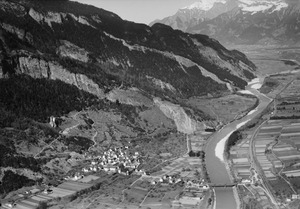Haldenstein facts for kids
Quick facts for kids
Haldenstein
|
||
|---|---|---|
 |
||
|
||
| Country | Switzerland | |
| Canton | Grisons | |
| District | Plessur | |
| Area | ||
| • Total | 18.56 km2 (7.17 sq mi) | |
| Elevation | 528 m (1,732 ft) | |
| Population
(December 2019)
|
||
| • Total | 1,090 | |
| • Density | 58.73/km2 (152.1/sq mi) | |
| Postal code |
7023
|
|
| Surrounded by | Chur, Felsberg, Pfäfers (SG), Trimmis, Untervaz | |
Haldenstein was once a town, also called a municipality, in the Plessur Region of Switzerland. It was located in the canton of Grisons. On January 1, 2021, Haldenstein joined the nearby city of Chur.
Contents
History of Haldenstein
Haldenstein was first mentioned in old records in the year 1149. Back then, it was known by the name Lanze. Later, in 1370, it was called Lentz inferior.
Geography and Landscape
Haldenstein covers an area of about 18.6 square kilometers (7.2 square miles). A large part of this land, about 53.9%, is covered by forests. About 25.6% of the land is used for farming. Only a small portion, 2.1%, has buildings or roads. The rest, 18.4%, is made up of rivers, glaciers, or mountains.
The town is located north of Chur. It sits on the left bank of the Rhine River. Haldenstein includes its main village, which is about 572 meters (1,877 feet) above sea level. It also has two smaller villages, called hamlets: Batänja (which used to be called Sewils) at 1,400 meters (4,593 feet) and Berg at 1,505 meters (4,938 feet).
The main village of Haldenstein is a haufendorf. This means it's an unplanned village where buildings are packed closely together around a central area. The boundaries of the municipality stretch from the Rhine River up to the Calanda mountain. This mountain forms the border with the canton of St. Gallen.
People and Population
In 2019, Haldenstein had a population of 1,090 people. About 9.9% of the people living there in 2008 were from other countries. Over the ten years leading up to 2008, the population grew by almost 20%.
Most people in Haldenstein speak German. In 2000, about 92.8% of the population spoke German. Italian was the second most common language, spoken by 2.8% of the people. The Romansh language was spoken by 2.0% of the population.
Education and Work
Many adults in Haldenstein have a good education. About 83.9% of people aged 25 to 64 have finished high school or gone on to higher education, like a university.
Haldenstein has a low unemployment rate, which means most people who want to work can find jobs. In 2005, about 24 people worked in farming. There were also 114 people working in manufacturing and construction. Another 105 people worked in the service industry, like shops or offices.
Population Changes Over Time
The number of people living in Haldenstein has changed over many years. Here is a look at the population at different times:
| year | population |
|---|---|
| 1803 | 349 |
| 1850 | 492 |
| 1900 | 464 |
| 1950 | 521 |
| 1990 | 677 |
| 2000 | 808 |
Important Historical Sites
Haldenstein is home to some important historical places. The Ruins of Haldenstein fortress and Schloss Haldenstein are both listed as Swiss heritage sites of national significance. This means they are very important to the country's history and culture.
Famous People
The famous architect Peter Zumthor has a small studio in Haldenstein where he works. He has won many awards for his building designs.
See also
 In Spanish: Haldenstein para niños
In Spanish: Haldenstein para niños












